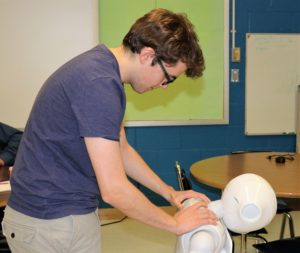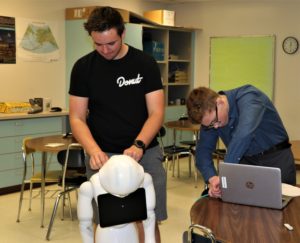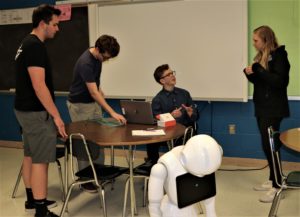by Stephanie Fox
Standing in a nearly empty classroom, three students crowded around a massive cardboard box, removing padding and clearing the way for the robot inside. Within minutes, they had extracted and turned on the robot, whose abilities they will test and manipulate this spring.

Joe Lewis turns Pepper on for the first time since removing it from the box. (Stephanie Fox/Northwestern University)
South River High School juniors John Hair, Jacob Haley and Joe Lewis partnered with the Smithsonian Environmental Research Center (SERC) to develop a program for the robot that improves environmental literacy.
The robot they’re programming is just one of 12 “Pepper” robots SoftBank Robotics donated to the Smithsonian in February 2018.
“It was a pilot project trying to see if these Pepper robots could be used in an educational museum or research setting,” said Cosette Larash, a public engagement program assistant at SERC.
Robotics for the Environment
Of the two Peppers at SERC, one came with a plug-and-chug software and resides in SERC’s Reed Education Center. That robot, whose tablet-like chest contains slides about SERC, comes out on some weekends and special events to interact with the public.
Read more: Meet Pepper, the Android Docent
The other Pepper has sat in a box since last spring, when three other students at South River High School, a magnet school near SERC, began investigating the robot’s capabilities.
“We initially asked SERC if there was anything within the organization that we could get involved with.… We got lucky because Pepper was introduced to SERC right around the same time,” said Mark Schrader, a South River High School teacher. Schrader also acts as an advisor for the Community Challenge class, which selects STEM-based community projects for students, like programming Pepper. “It kind of all came together in perfect timing. They asked us if we had some kids who’d be willing to dive in with Pepper and see if they could get Pepper usable.”

Jacob Haley (left) and John Hair (right) plug Pepper into their laptop. (Photo: Stephanie Fox/Northwestern University)
This April, the second Pepper reemerged from the box for a new trio of students to pick up where the first group left off. Hair, Haley and Lewis plan to build on last year’s work as part of their final Community Challenge project.
They hope to develop a program that makes environmental issues more accessible to the public, particularly those impacting Chesapeake Bay. Uploading a program like this into a child-sized robot makes learning about issues like climate change less intimidating.
The three students aren’t sure what exactly this software will look like, but they have a clear goal in mind.
“The more people that are aware of [environmental issues], the sooner today’s issues can be solved,” said Haley. “We hope to inspire people to go out there and learn and research.”
Rising to the Community Challenge
The Community Challenge course is part of a larger STEM program offered at South River. Rising freshman can apply to a lottery that picks students for the program. If selected, they spend the next four years taking STEM classes. By sophomore year, the students choose a “major” within the realm of science, technology, engineering and mathematics. During junior year they spend either their spring or fall semester taking the Community Challenge class. The first month focuses on technical writing, professional email writing, public speaking and professional attire. At the end of that semester, they work in groups of three or four on projects based on their interests. They finish the STEM Program with a capstone project their senior year.

The students explain their plans for Pepper to SERC staff member Cosette Larash. (Photo: Stephanie Fox/Northwestern University)
“Our teachers said at the beginning of the [Community Challenge] class, before we got the challenge, that they were ‘watching us,’” Lewis joked. Some students are helping organize the Bowie Baysox STEM Day, which offers STEM activities during the Baysox baseball game. Others are working with the Stop the Bleed initiative, engineering cost-effective training materials that show how to help someone bleeding.
The three students working with Pepper are in the computer science “major.” Each has a background in robotics. In middle school, Hair participated in the FIRST LEGO League, an international robotics competition for elementary and middle school students. Haley and Lewis have been active participants of the high school robotics team for two years. Both students will hold executive positions their senior year.
Hair, Hayley and Lewis will spend the rest of their semester determining how to program Pepper to improve environmental literacy. On June 6, all Community Challenge participants will present their final projects to a panel of judges, who will then decide which group should present to an auditorium of over 500 people.
It’s a good thing part of their Community Challenge training included giving speeches.
